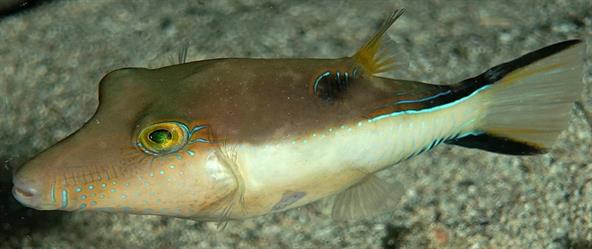



Canthigaster rostrata
| Ecological Descriptors |
||||
| Habitat | Size | Diet | Behaviour | Sex |
| R, Co (S) | 12 | Veg, Spo, Cru, Mol, Wor, Ech | I, Ter | F |
General:
Although confused by some with porcupinefish (Diodontidae [="two teeth"]), Pufferfish (Tetrodontidae [="four teeth"]) differ in their beak-like teeth are not bring fully fused, having a noticable groove (median suture) and lack obvious spines on the body. Both families have the ability to enlarge themselves as a predator deterrent.
Description:
Dark olive-brown upper body and white to yellowish ventrally. Pale/ white tail with dark borders (unlike similar Goldface Toby, C. jamestyleri, which lacks these tail borders). Scattered small blue spots/ lines on head and body. Blue lines around mouth & eyes. Usually dark spot at base of dorsal fin.
Ecology
Inhabits reefs and marginal habitats such as seagrass beds. Diet consists of seagrass, sponges, crabs and other crustaceans, molluscs, polychaete worms, sea urchins, starfishes, hydroids and algae
Life Cycle:
The female lays eggs on the sea bed.). Males in the territory visit their females regularly throughout the day, and during breeding season the visits typically result in spawning at dawn, or very early in the morning. When ready to mate, males enter a female’s territory and spread its fins, if the female shows a mottled colour she is indicating a submissive display and is ready to mate. The female will search for a patch of algae and spend some time cleaning it while the male nudges her constantly with his snout . Once the patch is prepared, the female lays her eggs into it and the male fertilises them immediately. Once laid, the individuals resume protecting their territories and the eggs are uncared for. Sharpnose puffers typically mate during dawn hours of the Spring, however the full extent of the breeding season is unknown.
Although confused by some with porcupinefish (Diodontidae [="two teeth"]), Pufferfish (Tetrodontidae [="four teeth"]) differ in their beak-like teeth are not bring fully fused, having a noticable groove (median suture) and lack obvious spines on the body. Both families have the ability to enlarge themselves as a predator deterrent.
Description:
Dark olive-brown upper body and white to yellowish ventrally. Pale/ white tail with dark borders (unlike similar Goldface Toby, C. jamestyleri, which lacks these tail borders). Scattered small blue spots/ lines on head and body. Blue lines around mouth & eyes. Usually dark spot at base of dorsal fin.
Ecology
Inhabits reefs and marginal habitats such as seagrass beds. Diet consists of seagrass, sponges, crabs and other crustaceans, molluscs, polychaete worms, sea urchins, starfishes, hydroids and algae
Life Cycle:
The female lays eggs on the sea bed.). Males in the territory visit their females regularly throughout the day, and during breeding season the visits typically result in spawning at dawn, or very early in the morning. When ready to mate, males enter a female’s territory and spread its fins, if the female shows a mottled colour she is indicating a submissive display and is ready to mate. The female will search for a patch of algae and spend some time cleaning it while the male nudges her constantly with his snout . Once the patch is prepared, the female lays her eggs into it and the male fertilises them immediately. Once laid, the individuals resume protecting their territories and the eggs are uncared for. Sharpnose puffers typically mate during dawn hours of the Spring, however the full extent of the breeding season is unknown.
Sharpnose Pufferfish



178







